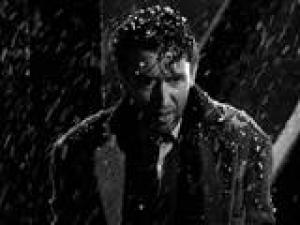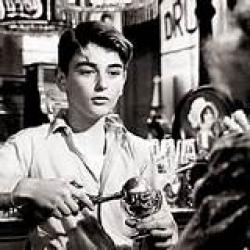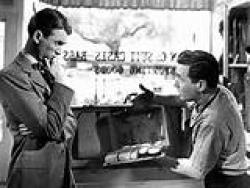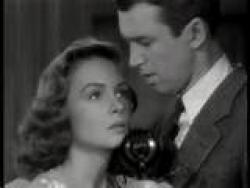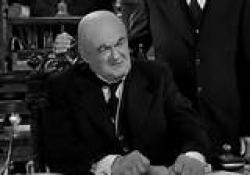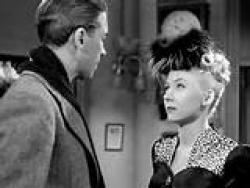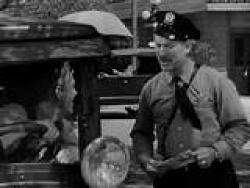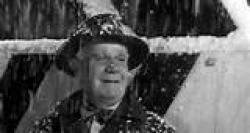Capra’s Christmas Cracker
By Michael Roberts
"I just said, Frank, if you want to do a movie about me committing suicide, with an angel with no wings called Clarence, I'm your boy"
~ Jimmy Stewart
If Frank Capra, after John Ford, was not the biggest director in Hollywood in 1942, he was the certainly most consistently popular and populist, a kind of Stephen Spielberg of his time, but as fate would have it he would never make another hit film. In 1946, after 4 years of war service and making propaganda films for the US military, Capra chose a sentimental fable to mark his return to features, casting another Hollywood figure struggling to find his way in the post war environment, Jimmy Stewart, and the pair waded into an uncertain future. Capra sourced the project from a short story called The Greatest Gift, by Philip Van Doren Stern, and had it adapted by husband and wife team Francis Goodrich and Albert Hackett.
Capra, once the gem in Columbia’s crown, was now unattached to any studio and started the trend of stars and directors who were forming their own, independent companies after the war, forming Liberty Pictures with fellow directors William Wyler and George Stevens, aiming to produce their own work without studio interference. RKO had initially owned the film rights to the Van Doren Stern story, commissioning a script by Dalton Trumbo, and had wanted Cary Grant to play the central figure until Capra took it over in 1945. Capra, along with his star from Mr Smith Goes to Washington, and You Can't Take it With You and started filming in April 1946, making the most expensive picture of his illustrious career, and therefore, financially, one of the biggest flops.
George Bailey (James Stewart) is a small town boy with ambition to see the world. He refuses the chance to follow in his father’s footsteps and take a job at a savings and loans society, packing his bags for a trip around the world. Reality keeps intervening and George becomes a key personality in the heartland town of Bedford Falls, as he acts as a bulwark against arch capitalist Potter (Lionel Barrymore). Mary (Donna Reed) beguiles him at a local dance and eventually the pair marries and has four children, further entrenching George in his small town malaise. A crisis at the loans society forces George to face the depth of his unhappiness and the idea that he’d never become what he’d dreamt he’d become, so he decides to kill himself. Fate intervenes in the unlikely form of Clarence (Henry Travers), a guardian angel, who hits upon a device to show George the error of his ways.
Capra set out to create an idealised version of small town America, and in many ways his construction is just as outrageous a fantasy as any angel coming down from heaven to intervene in the affairs of men. Capra may have been unwittingly more accurate in his depiction of Pottersville, a riot of iniquity and Bacchanalian excess, than he would care to admit. The film is essentially about dreams unrealised, about a man who settles for duty and the mundane over the bigger and riskier option of leaving hearth and home and finding what the world has to offer. In this version George is something of a cipher for Capra himself after the war, someone who wants to achieve, “something big, something important,” and who doubts his own worth when a crisis appears. As in the war, duty and service comes at a price.
Capra may have thought he was delivering a clear and decisive statement about traditional values, but the body and content of the film reveals just how out of touch he was with his own art, and also with the Film Noir aesthetic of his many of his post war peers. The film is a succession of contradictions and contrasting ideas – at one point mob mentality equates with greed, at another with charity, we see George cherish his family, and then lapse into gross resentment of them, all complex ideas to cohere, and from a man like Capra who would never have heard the term ‘existential crisis’. Capra’s difficulty was the same one that art has struggled with for centuries, of how to deliver a nuanced argument in myriad shades of grey when the world is conditioned to wanting delineation of ideas and easy answers in stark black or white. George embodies this dilemma, he is a passionate and devoted man, but the compromises he makes tears him up inside as he sublimates his own will for the good of others. George does his duty, and is so conflicted by it that he contemplates suicide, an extraordinary thing for a mainstream feature film in 1946, seemingly rejecting the values that Capra esteems.
Capra hoped to re-engage with the viewing public with a fable that affirmed ‘traditional’ American values, one worthy of Dickens, with A Christmas Carol serving as a key influence. Of course, as an immigrant Capra often felt the need to be the most ‘American’ of all Hollywood directors, a situation that also made him rankle at accusations of disloyalty when the anti-communist witch hunters looked (albeit obliquely) his way. Capra, the arch Christian, was also drawn to the supernatural aspect of the story, particularly the ‘unborn’ sequence where George is presented with Pottersville, a hard and depraved version of Bedford Falls, a world that would exist as a consequence of his never being born. Capra hoped to conjure a nostalgia for a simpler time, a time when all the old certainties were not undermined by the new order of a post atomic bomb reality, and of the quickly changing social mores.
Capra miscalculated, unlike after the end of WWI, when the world embraced the hedonism of the Jazz Age and the permissive theatre of the Weimar Republic, this time the public wanted to reassess the cost and meaning of the unthinkable loss and pain of the previous years. Capra’s partner in Liberty, William Wyler, touched on the pulse of the times with his incisive story, The Best Years of Our Lives, a film Capra passed on and disliked. Ironically Wyler’s film would win all the acclaim and awards while Capra’s languished, unloved for decades. Only after television consistently scheduled the film as a Christmas staple in the 1970’s did its reputation grow, until it justly became one of the most highly regarded of Capra’s films.
Not only was Capra at a crossroads after the war, the entire planet was reassessing and processing the results of the conflict against fascism, and of the reality of the atomic bomb. Stewart was unsure he could ever act again after what he’d seen and done as a pilot in Europe, bombing Germany on many missions and rising to the rank of Colonel, the most decorated of all the Hollywood figures who enlisted. Capra sensed his insecurity and urged Lionel Barrymore to give him a pep talk, but Barrymore’s angle might have taken him by surprise. According to Capra, Stewart told Barrymore that he didn’t think acting was ‘decent’ anymore, but Barrymore responded with a barb that knocked Stewart for six, “Was it any more decent to drop bombs on people than bring rays of sunshine into their lives with your acting talent”? After a couple of years of struggle Stewart worked his way back to the top of his profession, but It’s a Wonderful Life did nothing to advance that cause as the public did not take to it at all upon its initial release.
Stewart is ideal as the ‘everyman’ who sacrifices his own ambition for the sake of others, and delivers one of the finest performances of his career, in a demanding role that was his personal favourite. George is the heart and soul of the piece, the most fully realised of all the characters in the film. Indeed, Mary is a thinly sketched milksop of idealised virtue, a far cry from the women that worked in the factories during the war like Rosie the Riveter, and Potter is a caricature of the evil businessman, a cardboard villain from pantomime rather than an authentic reactionary, like the fascist Edward Arnold essayed for Riskin and Capra in Meet John Doe.. Capra is on far stronger ground with the supporting cast, a fine range of the best Hollywood could offer, from H.B Warner, Beulah Bondi, and Gloria Graeme to John Ford favourites, Thomas Mitchell and Ward Bond.
Capra, somewhat ironically, was known for creating films of ‘social comment’, but a director with less social consciousness would be hard to find, and whatever political subtext his classics films contained came courtesy of writers like Robert Riskin, not from Capra. Capra was an opportunist who provided films he thought would appeal to audiences, and through the depression he made films that championed the underdog, the ‘common’ man. Katharine Hepburn memorably described Capra’s unsophisticated political view as - “His own outlook was that of a fellow from Sicily coming into this country, that was his politics, pleased to be here.” Capra dabbled with causes that he thought would be advantageous to his career, but it’s clear that he was a right wing populist at heart, which makes it doubly ironic indeed that he would come under scrutiny from the egregious HUAC, and eventually be ‘greylisted’ for communist tendencies.
Capra’s political problems came about principally because he used left-leaning writers for most of his films, dozens of them over the years. It’s a Wonderful Life should have caused him more problems, particularly the depiction of the banker as a villain of epic proportions, as in truth a plethora of leftist writers had contributed to the script's gestation, including Dalton Trumbo, Clifford Odets, Michael Wilson and Dorothy Parker, names that would come back to haunt Capra when HUAC came to town. Hollywood was abuzz with talk of a blacklist and Capra was now dismayed to learn he would have to clear any casting with “that awful prick” John Wayne, a key member of the Motion Picture Alliance for the Preservation of American Ideals. Capra may have created a bulwark for himself by casting Ward Bond, one of Wayne’s best friends in a choice supporting role, as Bond was just as fanatically anti-Red as Wayne, and it’s possible that Capra was not called before HUAC because of his influence.
Regardless of Capra’s political beliefs it’s indisputable that he thought he was making films for a Christian nation, having grown up staunchly Catholic himself. He was attracted to the ‘spiritual’ dimension of the story, the power of answered prayers, and obviously would personally have had huge issues with communism, as right wing Catholics had everywhere post WWII. Capra’s confusion is that of a typical reactionary Catholic, attempting to embrace the doctrine of St Francis, of love for your fellow man etc, at one end and demanding sterile conformity and subjugation at the other and condemning those who fall short of the mark. Potter rails against the “discontented, lazy rabble” of the working class, the same community that “does all the working, paying and dying in this town,” according to George. The ambiguity of the character of the mob was lost on Capra, as he championed the virtue of old fashioned stereotypes, of a dutiful and obedient wife, a decent and devoted husband.
For all its myriad faults, It’s a Wonderful Life is a fine and engaging film about the power of love and family. It works best as a tribute to the determination of an ordinary man to connect with his family and community, in face of all the odds, and to carry out his dealings with others respectfully and ethically. The supernatural device is brilliantly executed as is the fleshing out of the small town characters, full of humour and spark, as in the cracking sequence where Gloria Graeme wiggles down Main Street in a tight skirt in the middle of the day, watched spellbound by George, Ernie the cabbie and Bert the Cop. Bert says casually, “I’m going home to see what the wife is doing”, to which Ernie responds, “Oh, a family man”. Capra provides one of his finest touches with the filming of the telephone sequence between George and Mary, superbly played by Stewart and Reed, one of the highlights of ‘40s cinema.
Frank Capra was an American auteur; he had the brains to work with great writers and had an instinct for what would play in the heartland as well as in the big cities. He left behind a considerable legacy of first rate films, and some second rate sentimental tosh (Spielberg again?) and was a self mythologiser of some note. It’s a Wonderful Life stands alongside his best work, enlivened by a supreme performance from Jimmy Stewart and by some inspired ensemble acting. It is a deeply humanist film, full of heart and soul and spirit, a fable to survive long after the simple and facile Christmas associations fade.
